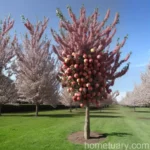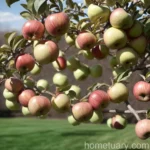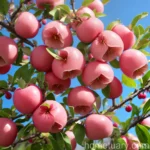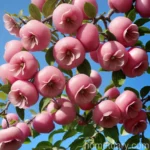Plant Scientist’s Guide to the Apple Tree (Malus pumila ‘Caitlin’ STARK GRANDGALA)
What is an Apple Tree (Malus pumila ‘Caitlin’ STARK GRANDGALA)?
Apple trees are iconic and highly valued for their delicious and nutritious fruits. The botanical name for the apple tree is Malus pumila, and it belongs to the Rosaceae family. The ‘Caitlin’ STARK GRANDGALA cultivar is a specific variety of the Malus pumila species that is known for its distinctive qualities, including its vibrant appearance and flavorful fruits.
Key Takeaways
- Apple trees, particularly the Malus pumila ‘Caitlin’ STARK GRANDGALA cultivar, are prized for their fruits, which are suitable for various culinary purposes.
- When cultivating apple trees, factors such as water, sunlight, fertilizer, soil, pruning, and propagation techniques must be carefully considered to ensure healthy and productive growth.
- Apple trees are susceptible to certain diseases and pests, necessitating careful monitoring and preventive measures for effective management.
Culture of the Apple Tree (Malus pumila ‘Caitlin’ STARK GRANDGALA)
Uses
The primary use of the apple tree, especially the ‘Caitlin’ STARK GRANDGALA cultivar, is the production of flavorful and versatile apples. These apples can be consumed fresh, used in cooking, or processed into various products such as juices, ciders, and preserves.
Water
- Apple trees, including the ‘Caitlin’ STARK GRANDGALA variety, require consistent moisture to support healthy growth and fruit production.
- Adequate watering, especially during dry periods, is essential to prevent water stress and ensure the development of quality fruits.
Sunlight
- Apple trees thrive in full sun, requiring at least 6-8 hours of sunlight daily for optimal growth and fruiting.
- Adequate sunlight exposure promotes photosynthesis, which is crucial for the production of carbohydrates and overall plant vigor.
Fertilizer
- The application of balanced fertilizers, particularly those with a higher potassium content, supports the development of healthy apple trees and promotes fruit quality.
- Fertilizer application should be tailored to the specific needs of the ‘Caitlin’ STARK GRANDGALA cultivar and the characteristics of the soil in which it is planted.
Soil
- Apple trees, including the ‘Caitlin’ STARK GRANDGALA variety, prefer well-draining soils with a slightly acidic to neutral pH (6.0-7.0).
- Rich, loamy soils that are high in organic matter are ideal for promoting vigorous growth and fruit production in apple trees.
Pruning
- Regular pruning is essential for shaping the tree, promoting airflow, and removing dead or diseased branches.
- Pruning also helps manage the size of the tree and encourages the development of fruit-bearing wood in the ‘Caitlin’ STARK GRANDGALA variety.
Propagation
- Apple trees are commonly propagated through grafting onto suitable rootstocks to ensure desirable traits and promote uniformity in the resulting trees.
- Techniques such as budding and whip-and-tongue grafting are often employed to propagate the ‘Caitlin’ STARK GRANDGALA cultivar and other apple tree varieties.
Container Popularity
While apple trees are traditionally grown in orchards and gardens, they can also thrive in containers, making them popular choices for urban and space-restricted environments.
Container
- When growing apple trees in containers, it is crucial to select large, sturdy containers with adequate drainage holes to support the development of the root system.
- Container-grown apple trees, including the ‘Caitlin’ STARK GRANDGALA cultivar, can be placed in suitable outdoor locations or on patios and balconies, provided they receive sufficient sunlight and care.
Common Diseases of the Apple Tree (Malus pumila ‘Caitlin’ STARK GRANDGALA)
Apple trees, including the ‘Caitlin’ STARK GRANDGALA variety, are susceptible to various diseases that can affect their overall health and fruit production. Proper disease management and timely interventions are essential to minimize the impact of these conditions and ensure the vitality of the trees. Some of the common diseases that can affect apple trees include:
-
Apple Scab (Venturia inaequalis): This fungal disease causes dark, scab-like lesions on the leaves and fruits, impacting the tree’s overall health and fruit quality.
-
Cedar Apple Rust (Gymnosporangium juniperi-virginianae): This disease, which requires both apple trees and cedar or juniper hosts, leads to the development of characteristic rust-colored lesions on the leaves and fruits.
-
Powdery Mildew (Podosphaera leucotricha): Powdery mildew can affect apple trees, leading to the formation of a white, powdery fungal growth on the leaves and buds.
-
Fire Blight (Erwinia amylovora): This bacterial disease causes wilting and blackening of the blossoms, shoots, and branches, posing a significant threat to the overall health of the apple tree.
-
Phytophthora Root Rot: Phytophthora species can cause root rot in apple trees, leading to the decline of the tree and impacting its ability to uptake water and nutrients.
Disease Diagnosis and Management
Disease Diagnosis
Accurately diagnosing diseases affecting apple trees is crucial for implementing appropriate management strategies and preventing the spread of the condition. Diagnosis can involve careful observation of symptoms, laboratory testing, and consulting with agricultural extension services or plant pathology experts. Common symptoms of diseases affecting apple trees, including the ‘Caitlin’ STARK GRANDGALA cultivar, can include leaf spots, lesions, wilting, and abnormal fruit development.
Common Pests
In addition to diseases, apple trees are also susceptible to various pests that can impact their growth and fruit production. Common pests that can affect apple trees, including the ‘Caitlin’ STARK GRANDGALA variety, include:
-
Apple Maggot (Rhagoletis pomonella): The larvae of this pest tunnel into the fruit, causing damage and rendering the fruits unmarketable.
-
Codling Moth (Cydia pomonella): Codling moth larvae can infest apple fruits, leading to the formation of tunnels and rendering the fruits unsuitable for consumption.
-
Aphids: These small insects can feed on the sap of apple trees, leading to leaf distortion and the potential transmission of viral diseases.
-
Apple Sawfly (Hoplocampa testudinea): The larvae of the apple sawfly can cause damage to apple fruits by feeding on them and causing deformations.
Botanist’s Tips for Disease and Pest Management
Effective disease and pest management in apple trees, such as the ‘Caitlin’ STARK GRANDGALA cultivar, requires a multifaceted approach that integrates cultural, biological, and chemical control methods. Some botanist’s tips for managing diseases and pests in apple trees include:
- Regular monitoring of the trees for early signs of diseases and pests.
- Implementing cultural practices such as proper sanitation, pruning, and mulching to minimize disease pressure.
- Employing biological control agents such as beneficial insects to manage pest populations.
- Using targeted chemical interventions when necessary, following recommended application rates and timing to minimize environmental impact.
Fun Facts about the Apple Tree (Malus pumila ‘Caitlin’ STARK GRANDGALA)
- The apple tree (Malus pumila) is considered one of the earliest trees to be cultivated and domesticated by humans, with a rich history spanning thousands of years.
- There are thousands of apple varieties, each with unique flavors, colors, and uses, showcasing the diversity of this beloved fruit.
- Apple trees are characterized by their beautiful blossoms in spring, which not only add to the tree’s aesthetic appeal but also attract pollinators essential for fruit production.
Links to External Resources
- Apple Tree Care Guide from the Royal Horticultural Society
- Apple Disease Management Guidelines from the University of California Agriculture and Natural Resources
- Pest Management in Apple Orchards by the Integrated Pest Management Program at the University of California
- Grafting and Propagation Techniques for Fruit Trees from the Penn State Extension
By understanding the cultural requirements, disease management strategies, and unique characteristics of the ‘Caitlin’ STARK GRANDGALA apple tree cultivar, plant enthusiasts and orchardists can cultivate healthy and productive apple trees that yield delicious fruits year after year. Whether in traditional orchards or urban gardens, the apple tree continues to hold a special place in horticulture and human culture, symbolizing resilience, abundance, and the joys of nature’s bounty.















